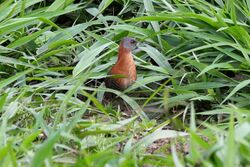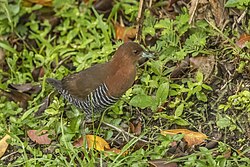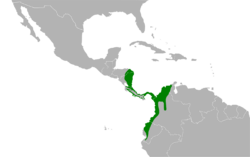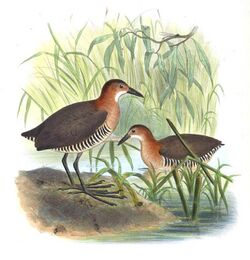Biology:White-throated crake
| White-throated crake | |
|---|---|

| |
| With grey face, Costa Rica | |

| |
| Rufous-faced, Colombia | |
| Scientific classification | |
| Domain: | Eukaryota |
| Kingdom: | Animalia |
| Phylum: | Chordata |
| Class: | Aves |
| Order: | Gruiformes |
| Family: | Rallidae |
| Genus: | Laterallus |
| Species: | L. albigularis
|
| Binomial name | |
| Laterallus albigularis (Lawrence, 1861)
| |

| |
The white-throated crake (Laterallus albigularis) is a species of bird in subfamily Rallinae of family Rallidae, the rails, gallinules, and coots. It is found in Colombia, Costa Rica, Ecuador, Honduras, Nicaragua, Panama, and Venezuela.[2][3]
Taxonomy and systematics
The white-throated crake was for a time treated as a subspecies of the rufous-sided crake (L. melanophaius).[4] As a species in its own right, it has three subspecies, the nominate L. a. albigularis, L. a. cinereiceps, and L. a. cerdaleus.[2]
Description
The white-throated crake is 14 to 16 cm (5.5 to 6.3 in) long. Males weigh about 50 g (1.8 oz) and females 45 g (1.6 oz). The sexes are alike. Adults of the nominate subspecies have a white throat and upper breast and a rufous face, sides of the neck, and lower breast. Their crown, nape, and upperparts are olive brown. Their belly, vent, and undertail coverts are barred black and white. Subspecies L. a. cinereiceps has a gray face and L. a. cerdaleus has an entirely rufous head and throat.[5]
Distribution and habitat
The nominate subspecies of white-throated crake is found along the Pacific side of southwestern Costa Rica and Panama and through northern and western Colombia into western Ecuador as far south as El Oro Province. L. a. cerdaleus is found in northern Colombia and extreme northwestern Venezuela. L. a. cinereiceps is found from southeastern Honduras along the Caribbean slope of Nicaragua and Costa Rica and into Panama as far as Veraguas Province.[2][5] The nominate subspecies has also occurred in Peru as a vagrant.[6]
The white-throated crake inhabits a variety of both wet and dry landscapes including marshes, wet grassy fields and pastures, thickets, forest clearings, and the edges of watercourses and ponds. In elevation it ranges from sea level to 1,600 m (5,200 ft).[5]
Behavior
Movement
The white-throated crake is generally sedentary but may relocate locally to higher ground during the rainy season.[5]
Feeding
The white-throated crake usually forages in cover but will move into the open at dawn and dusk and during rainy weather. Its diet includes insects, spiders, grass and sedge seeds, algae, and some small fruits.[5]
Breeding
The white-throated crake's breeding season varies geographically. It makes a sperical nest of woven grass stems and leaves with a side entrance, placed in a bush or grass tussock over water or ground. The typical clutch size is two to five eggs.[5]
Vocalization
The white-throated crake makes an "[a]brupt, explosive descending trill or churr"; its alarm call is "a sharp 'chip'" note.[5]
Status
The IUCN has assessed the white-throated crake as being of Least Concern. It has a large range but its population size and trend are not known. No immediate threats have been identified.[1] It is "[v]ery difficult to see and status unclear.[5]
References
- ↑ 1.0 1.1 BirdLife International (2016). "White-throated Crake Laterallus albigularis". IUCN Red List of Threatened Species 2016: e.T22692346A93349492. doi:10.2305/IUCN.UK.2016-3.RLTS.T22692346A93349492.en. https://www.iucnredlist.org/species/22692346/93349492. Retrieved 29 November 2022.
- ↑ 2.0 2.1 2.2 Gill, Frank; Donsker, David; Rasmussen, Pamela, eds (August 2022). "Flufftails, finfoots, rails, trumpeters, cranes, limpkin". IOC World Bird List Version 12.2. International Ornithologists' Union. https://www.worldbirdnames.org/new/bow/flufftails/.
- ↑ HBW and BirdLife International (2021) Handbook of the Birds of the World and BirdLife International digital checklist of the birds of the world. Version 6. Available at: http://datazone.birdlife.org/userfiles/file/Species/Taxonomy/HBW-BirdLife_Checklist_v6_Dec21.zip retrieved August 7, 2022
- ↑ Remsen, J. V., Jr., J. I. Areta, E. Bonaccorso, S. Claramunt, A. Jaramillo, D. F. Lane, J. F. Pacheco, M. B. Robbins, F. G. Stiles, and K. J. Zimmer. Version 24 July 2022. A classification of the bird species of South America. American Ornithological Society. https://www.museum.lsu.edu/~Remsen/SACCBaseline.htm retrieved July 24, 2022
- ↑ 5.0 5.1 5.2 5.3 5.4 5.5 5.6 5.7 Taylor, B. (2020). White-throated Crake (Laterallus albigularis), version 1.0. In Birds of the World (J. del Hoyo, A. Elliott, J. Sargatal, D. A. Christie, and E. de Juana, Editors). Cornell Lab of Ornithology, Ithaca, NY, USA. https://doi.org/10.2173/bow.whtcra1.01 retrieved November 29, 2022
- ↑ Remsen, J. V., Jr., J. I. Areta, E. Bonaccorso, S. Claramunt, A. Jaramillo, D. F. Lane, J. F. Pacheco, M. B. Robbins, F. G. Stiles, and K. J. Zimmer. Version 24 July 2022. Species Lists of Birds for South American Countries and Territories. https://www.museum.lsu.edu/~Remsen/SACCCountryLists.htm retrieved July 24, 2022
Wikidata ☰ Q1268156 entry
 |



